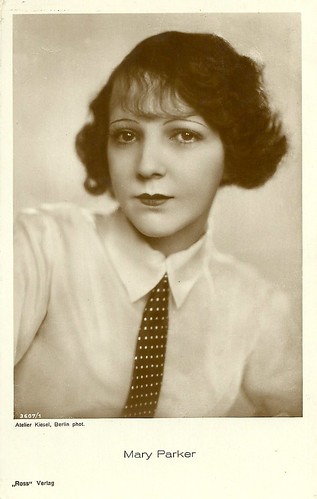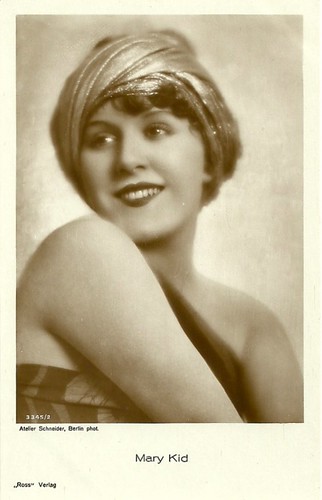Despite her English sounding name, Mary Parker (1902-?) was a Polish actress who was active in the German cinema of the late silent era. Little is known about her life.
![Mary Parker]()
German postcard by Ross Verlag, no. 3607/1, 1928-1929. Photo: Atelier Kiesel, Berlin.
Mary Parker was born Magdalena Prohaska in Breslau (today Wroclaw, Poland), in 1902. She debuted in the German cinema in 1924 in Die schönste Frau der Welt (Richard Eichberg, 1924) starring Lee Parry.
Quickly followed several other films, such as the comedy Lumpen und Seide (Richard Oswald, 1924), in which the rich Irene (Mary Parker) tries to refresh her marriage with Erik (Johannes Riemann) by taking a girl from the slums, Hilda, (Mary Kid) into their home. Hilda has a fiancee, Max, who is a shameless profiteer (Reinhold Schunzel).
Other memorable titles are Die Schmetterlingsschlacht (Franz Eckstein, 1924) starring Asta Nielsen, the Swiss production Das Paradies Europas. Bild vom Schweizer Volk und seinen Bergen (Walther Zürn, 1924-1925), and Zaungäste des Lebens (Nikolai Malikoff, 1925) with Angelo Ferari.
In Halbseide (Richard Oswald, 1925), Parker had the female lead opposite Bernd Aldor as her husband. She also had a major part in the comedy Vorderhaus und Hinterhaus (Richard Oswald, Carl Wilhelm, 1925) about a widower (Max Adalbert) who sublets a part of his house to the girl of his dreams (Parker) and her family, and in the sex education film Dürfen wir schweigen (Richard Oswald, 1926) about a painter (Conrad Veidt) who refuses to be treated for his venereal disease.
In the following years Parker also played in films like Ich hab mein Herz in Heidelberg verloren (Arthur Bergen, 1926), Das süsse Mädel (Manfred Noa, 1926), the Danish film Dydsdragonen (Valdemar Andersen, 1927), and Todessturz im Zirkus Cesarelli ( Karoly Lajthay, 1927).
In 1928 Parker had the female leads in two films: Heut' war ich bei der Frieda (Siegfried Philippi, 1928), which title refers to the hit song of 1927, and the romantic comedy Wer das Scheiden hat erfunden (Wolfgang Neff, 1928) in which Parker played the Russian aristocrat Ljuba Pawlowa.
The song Heut' war ich bei der Frieda (text: Fritz Rotter, music: Jim Crowley): "Heut war ich bei der Frieda, das tu’ ich morgen wieder.
Denn so was wie die Frieda war noch nie da." Source: Ilja Livschakoff (YouTube).
Mary Parker had a supporting role in Saxophon-Susi (Carl Lamac, 1928) starring Anny Ondra. In 1929 Parker had the lead of the military comedy Fräulein Fähnrich (Fred Sauer, 1929), playing opposite Willi Forstand Fritz Schulz.
Her last silent role was in Ja, ja, die Frauen sind meine schwache Seite (Edmund Heuberger, 1929). The year after she played in her first sound film, the Truus van Aalten comedy Susanne macht Ordnung (Eugen Thiele, 1930).
All in all she did some 17 silent films, of which several together with Hans Albers (Halbseide, Vorderhaus und Hinterhaus, Wer das Scheiden hat erfunden, Saxophon-Susi, Heut' war ich bei der Frieda, and Ja, ja, die Frauen sind meine schwache Seite) and Mary Kid (Lumpen und Seide, Halbseide, Vorderhaus und Hinterhaus, Dydsdragonen).
Parker had just a few performances in German sound films. After Susanne macht Ordnung she had a smaller part in Die unheimliche Geschichte (1932) by her regular director Richard Oswald and a real bit part in the Anny Ondra vehicle Die Unwiderstehliche (Geza von Bolvary, 1937), before she quitted altogether.
It is not known when or where Mary Parker died.
![Mary Kid]()
Mary Kid. German postcard by Ross Verlag, no. 3345/2, 1928-1929. Photo: Atelier Schneider, Berlin.
Sources: Thomas Staedeli (Cyranos), Filmportal.de, and IMDb.

German postcard by Ross Verlag, no. 3607/1, 1928-1929. Photo: Atelier Kiesel, Berlin.
Girl From the Slums
Mary Parker was born Magdalena Prohaska in Breslau (today Wroclaw, Poland), in 1902. She debuted in the German cinema in 1924 in Die schönste Frau der Welt (Richard Eichberg, 1924) starring Lee Parry.
Quickly followed several other films, such as the comedy Lumpen und Seide (Richard Oswald, 1924), in which the rich Irene (Mary Parker) tries to refresh her marriage with Erik (Johannes Riemann) by taking a girl from the slums, Hilda, (Mary Kid) into their home. Hilda has a fiancee, Max, who is a shameless profiteer (Reinhold Schunzel).
Other memorable titles are Die Schmetterlingsschlacht (Franz Eckstein, 1924) starring Asta Nielsen, the Swiss production Das Paradies Europas. Bild vom Schweizer Volk und seinen Bergen (Walther Zürn, 1924-1925), and Zaungäste des Lebens (Nikolai Malikoff, 1925) with Angelo Ferari.
In Halbseide (Richard Oswald, 1925), Parker had the female lead opposite Bernd Aldor as her husband. She also had a major part in the comedy Vorderhaus und Hinterhaus (Richard Oswald, Carl Wilhelm, 1925) about a widower (Max Adalbert) who sublets a part of his house to the girl of his dreams (Parker) and her family, and in the sex education film Dürfen wir schweigen (Richard Oswald, 1926) about a painter (Conrad Veidt) who refuses to be treated for his venereal disease.
In the following years Parker also played in films like Ich hab mein Herz in Heidelberg verloren (Arthur Bergen, 1926), Das süsse Mädel (Manfred Noa, 1926), the Danish film Dydsdragonen (Valdemar Andersen, 1927), and Todessturz im Zirkus Cesarelli ( Karoly Lajthay, 1927).
In 1928 Parker had the female leads in two films: Heut' war ich bei der Frieda (Siegfried Philippi, 1928), which title refers to the hit song of 1927, and the romantic comedy Wer das Scheiden hat erfunden (Wolfgang Neff, 1928) in which Parker played the Russian aristocrat Ljuba Pawlowa.
The song Heut' war ich bei der Frieda (text: Fritz Rotter, music: Jim Crowley): "Heut war ich bei der Frieda, das tu’ ich morgen wieder.
Denn so was wie die Frieda war noch nie da." Source: Ilja Livschakoff (YouTube).
Alive?
Mary Parker had a supporting role in Saxophon-Susi (Carl Lamac, 1928) starring Anny Ondra. In 1929 Parker had the lead of the military comedy Fräulein Fähnrich (Fred Sauer, 1929), playing opposite Willi Forstand Fritz Schulz.
Her last silent role was in Ja, ja, die Frauen sind meine schwache Seite (Edmund Heuberger, 1929). The year after she played in her first sound film, the Truus van Aalten comedy Susanne macht Ordnung (Eugen Thiele, 1930).
All in all she did some 17 silent films, of which several together with Hans Albers (Halbseide, Vorderhaus und Hinterhaus, Wer das Scheiden hat erfunden, Saxophon-Susi, Heut' war ich bei der Frieda, and Ja, ja, die Frauen sind meine schwache Seite) and Mary Kid (Lumpen und Seide, Halbseide, Vorderhaus und Hinterhaus, Dydsdragonen).
Parker had just a few performances in German sound films. After Susanne macht Ordnung she had a smaller part in Die unheimliche Geschichte (1932) by her regular director Richard Oswald and a real bit part in the Anny Ondra vehicle Die Unwiderstehliche (Geza von Bolvary, 1937), before she quitted altogether.
It is not known when or where Mary Parker died.

Mary Kid. German postcard by Ross Verlag, no. 3345/2, 1928-1929. Photo: Atelier Schneider, Berlin.
Sources: Thomas Staedeli (Cyranos), Filmportal.de, and IMDb.